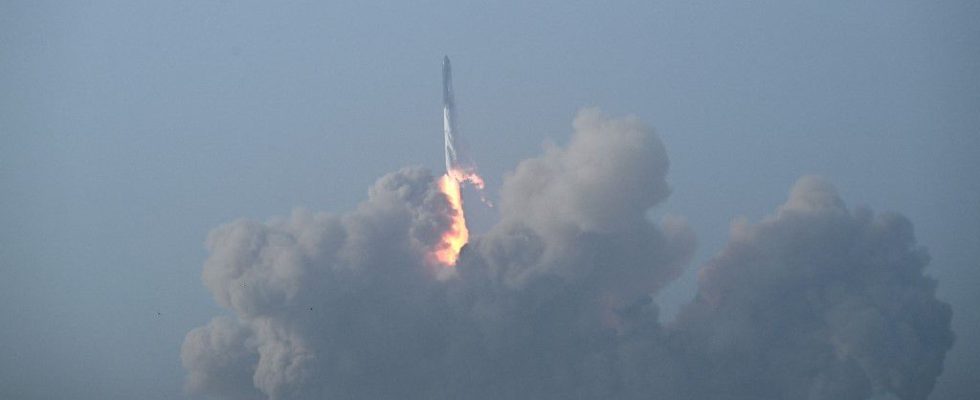A few strange rotations 30 km above the ground, before evaporating in a gigantic plume of smoke. It is 3:37 p.m. when the most powerful rocket in the world, launched this Thursday, April 20 by the American company SpaceX, explodes after four minutes of flight. A few seconds earlier, the “Super Heavy” and its 33 engines (a record) should have detached from the upper part (Starship) to calmly finish its journey in the Gulf of Mexico. The other piece would then have continued on its way until it reached an altitude of 150 km, then made almost a full circle around the Earth before plunging into the Pacific Ocean.
3:38 p.m. The ashes are not yet completely dissipated. The Starbase in Boca Chica, Texas, where the launch was taking place, is elated regardless. The boss of the company, Elon Musk, also greets him in the wake of a “tremendous first test”. His words reflect his relief in the face of a black scenario: that of an explosion which would have occurred upon takeoff, without the 120-meter-long machine having been able to taste the joys of the stratosphere. “We clear the Tower” (“We passed the umbilical tower, attached to the rocket on the launch pad”), we welcome in the live event broadcast by SpaceX on YouTube and Twitter. No explosion on the ground, no costly reconstruction to carry out. The rocket took off. And that already means a lot. “It’s a change of era. The whole of space will be reconfigured with the potential of this type of launcher”, wants to believe Philippe Coué, author of the book The Legacy of the Apollo Program: The Legacy of the Moon (2019).
There are many reasons for satisfaction. “During the thrust phase, the launcher resisted ‘Max Q’, the maximum dynamic pressure phase, where we can normally expect all kinds of problems”, continues the expert. Four minutes among the most precious ever observed by SpaceX. “The company was testing this huge launcher and its ship together for the first time. SpaceX now has data on the launcher’s propulsion, flight dynamics and behavior up to operational altitude. The test certainly didn’t go as far as ‘in the end, but the elements collected will be extremely useful,’ explains Xavier Pasco, director of the Foundation for Strategic Research (FRS) and expert in the space field.
“SpaceX must succeed”
The contract therefore seems well fulfilled. “The engineers will be able to replay the flight, apply corrective measures. This has been SpaceX’s method for fifteen years now with its ‘Falcons’ and which has borne fruit: test, fail, and test again until it succeeds”, deciphers Philippe Coué. The company led by tech troublemaker Elon Musk should still draw conclusions from the explosion. “Not all the engines ignited on takeoff,” says Xavier Pasco. A problem that would have contributed to deviating the rocket from its nominal trajectory, having to take it to the desired orbit, then to make it rotate. Six, out of the 33 “Raptor” models in the booster, would have failed, as shown by several images posted on social networks. It must be said: the firing of such a large number of engines – essential to operate a thrust of nearly 7,600 tons – was again a first.
This important step completed, the next will be the separation of the two stages of the rocket and their return to Earth without damage for reuse. They will arrive sooner or later, say confident prestigious observers. “Never confuse trial with failure. As you say in #BocaChica : ‘it’s not an explosion, it’s just a quick and unplanned dismantling […] Far from being a fatality, the shooting of the day will be a source of lesson”, commented the French astronaut Thomas Pesquet. The boss of NASA, Bill Nelson, also congratulated SpaceX. “Any great success in History has asked for a certain level of calculated risk,” he wrote on Twitter, explaining that he was “looking forward” to the next flight that Musk hopes “in a few months”.
This impatience can be heard. Starship must make it possible by 2025 to bring humans (and tons of material) back to the Moon thanks to NASA’s Artemis 3 program. “SpaceX is doomed to succeed, because time is running out: 2025 is very very optimistic to return to the Moon. What’s more, the Americans’ main rival, China, is moving fast. The country will bring its astronauts to the Moon in 2029, as announced this winter, in order to stick to the 80th anniversary of the founding of the Republic People’s Republic of China”, remarks Philippe Coué. The pressure is growing on Musk. The billionaire also received, at the end of 2022, authorization from the American authorities to complete his constellation of satellites, Starlink. Up to 40,000 vehicles in orbit are expected to provide its service with optimal operation. For the time being, only 3000 revolve around the Earth. “It would take no less than 200 Starships to launch them all,” said Philippe Coué. Without exploding this time.
